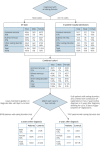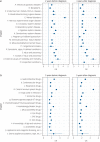Shining the light on eating disorders, incidence, prognosis and profiling of patients in primary and secondary care: national data linkage study
- PMID: 31256764
- PMCID: PMC7557634
- DOI: 10.1192/bjp.2019.153
Shining the light on eating disorders, incidence, prognosis and profiling of patients in primary and secondary care: national data linkage study
Abstract
Background: Diagnosing eating disorders can be difficult and few people with the disorder receive specialist services despite the associated high morbidity and mortality.
Aims: To examine the burden of eating disorders in the population in terms of incidence, comorbidities and survival.
Method: We used linked electronic health records from general practitioner and hospital admissions in Wales, UK within the Secure Anonymised Information Linkage (SAIL) databank to investigate the incidence of new eating disorder diagnoses. We examined the frequency of comorbid diagnoses and prescribed medications in cases and controls in the 2 years before and 3 years after diagnosis, and performed a survival analysis.
Results: A total of 15 558 people were diagnosed with eating disorders between 1990 and 2017. The incidence peaked at 24 per 100 000 people in 2003/04. People with eating disorders showed higher levels of other mental disorders (odds ratio 4.32, 95% CI 4.01-4.66) and external causes of morbidity and mortality (odds ratio 2.92, 95% CI 2.44-3.50). They had greater prescription of central nervous system drugs (odds ratio 3.15, 95% CI 2.97-3.33), gastrointestinal drugs (odds ratio 2.61, 95% CI 2.45-2.79) and dietetic drugs (odds ratio 2.42, 95% CI 2.24-2.62) before diagnosis. These excess diagnoses and prescriptions remained 3 years after diagnosis. Mortality was raised compared with controls for some eating disorders, particularly in females with anorexia nervosa.
Conclusions: Incidence of diagnosed eating disorders is relatively low in the population but there is a major longer term burden in morbidity and mortality to the individual.
Keywords: Eating disorder; anorexia nervosa; bulimia nervosa; epidemiology; incidence.
Conflict of interest statement
Figures



References
-
- Steinhausen HC. The outcome of anorexia nervosa in the 20th century. Am J Psychiatry 2002; 159: 1284–93. - PubMed
-
- Vitousek K, Watson S, Wilson GT. Enhancing motivation for change in treatment-resistant eating disorders. Clin Psychol Rev 1998; 18: 391–420. - PubMed
-
- Kyriacou O, Treasure J, Schmidt U. Understanding how parents cope with living with someone with anorexia nervosa: modelling the factors that are associated with carer distress. Int J Eat Disord 2008; 41: 233–42. - PubMed
Publication types
MeSH terms
Grants and funding
LinkOut - more resources
Full Text Sources
Medical

